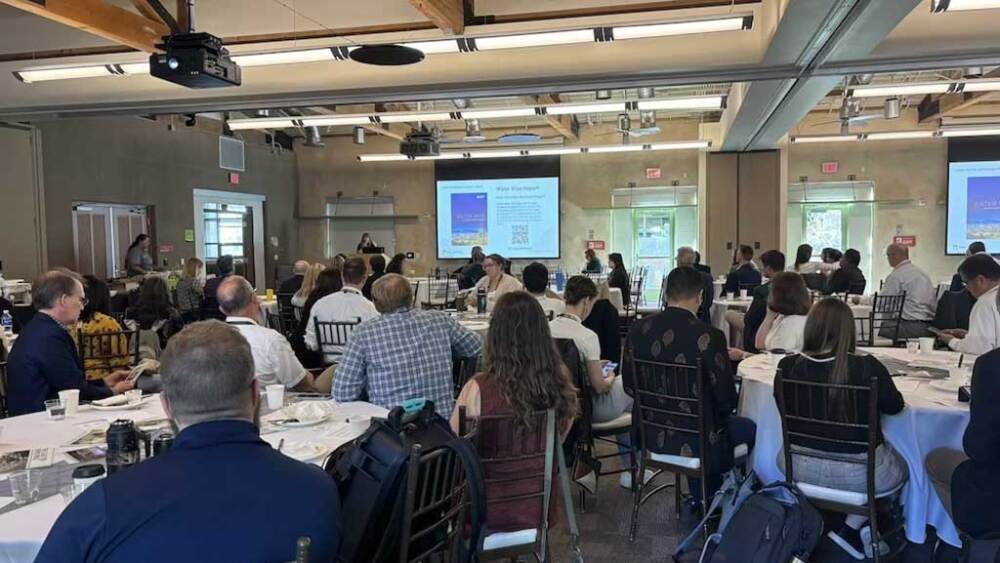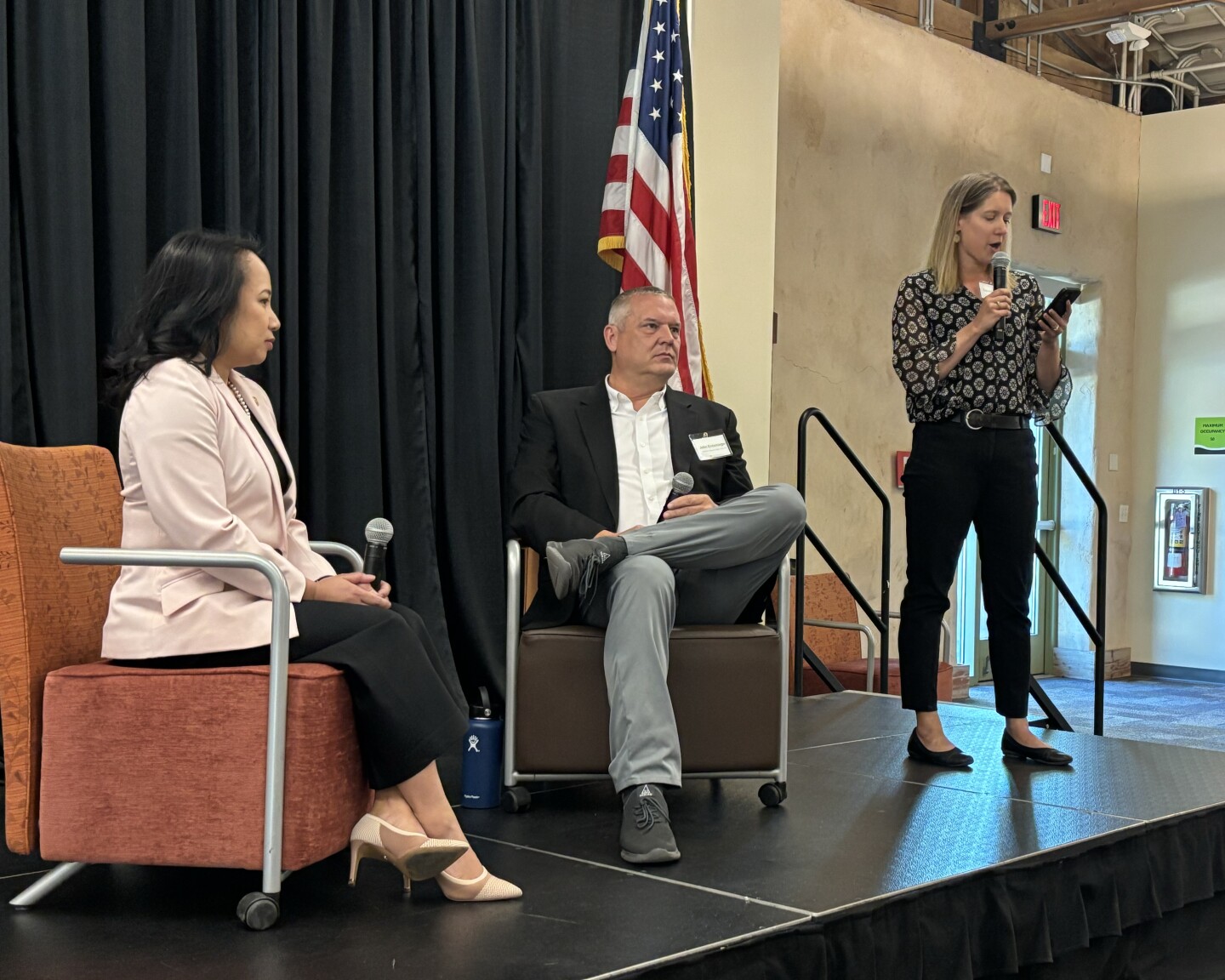Las Vegas, the driest major metropolitan area in the U.S., exemplifies the challenges of urban water management in arid regions, according to Colby Pellegrino, deputy general manager of resources for the Southern Nevada Water Authority (SNWA), the local water provider for the greater Clark County area, which serves about 2.3 million residents and 41 million annual visitors.
The Strip’s reputation for excess masks the stark reality Vegas faces: a struggle for water in the desert.
“We have to remember that we live in the Mojave Desert,” Pellegrino said in an opening presentation at the 2024 Lewis Center Sustainability Forum at the ULI Fall Meeting, located three miles from the Strip at the Springs Preserve, where 180 acres (72.8 hectares) of flora and fauna native to the Mojave Desert thrive in both natural and restored habitats. “Our city is branded in this very provocative way: Anything can happen here. What happens here stays here. But outside of the Strip corridor, that is not what living in Southern Nevada looks like.”
Water scarcity: a global problem with real estate implications
Marianne Eppig, senior director of urban resilience at ULI, stressed that water scarcity is a global problem.
“America is using most of its groundwater,” she said. “So this is a national issue, and we’re seeing other studies showing that this is also an international [issue].”
Water scarcity is making the resource more expensive for real estate owners and builders. According to Eppig, the price of water rights (entitlements to use water from a specific source, typically regulated by state laws) and water rates (charged by water utilities for the delivery of water to consumers) have risen faster than inflation.
“Public officials at all levels of government increasingly recognize freshwater scarcity as a threat to their communities and are enacting drought-related policies to address water stress,” Eppig said. “Many of these policies affect land use and real estate, such as. . .measures taken to ban new development, [which] will impact real estate markets and [reduce] affordability.”
According to Eppig, developers can mitigate the risks posed by water shortages, policy changes, and rising prices by investing in water efficiency and conservation measures “at the site scale.”
A later panel on water-wise development offered some site-scale case studies. The landscape architect Greg Dorolek, principal partner at Wenk Associates, discussed innovative stormwater management practices, emphasizing the use of natural landscapes to manage water efficiently. He highlighted the transformation of industrial sites into sustainable, thriving communities through the integration of stormwater treatment systems.
Karen Mahrous, senior vice president and head of ESG at Clarion Partners, detailed initiatives like retrofitting properties with low-flow fixtures and implementing water monitoring systems, which have led to significant water savings and financial benefits. Tenants in Class A offices prefer buildings with water-saving elements and expect transparency when it comes to sustainability data, she said.
“You assume your buildings are well managed. . .but until you install the [right] technology, [you don’t have] full visibility,” she said.
Jacob Atalla, vice president of sustainability at KB Home, said homebuyers have been quick to embrace low-flow fixtures and other water-saving elements at the firm’s residential developments.
“We’ve never had an issue with a homeowner saying, Hey, I don’t like the fixtures or the front lawn,” Atalla said. “We’re saving them money and also giving them resilience at the same time.”
Southern Nevada’s unique water challenges–and solutions
The majority of Clark County’s potable water comes from the Colorado River Basin, which is enduring a decades-long drought. In 2022, it hit the lowest level since filling in 1937, according to Camille Calimlim Touton, Commissioner, U.S. Bureau of Reclamation, who sat beside John Entsminger, general manager of SNWA, in an afternoon session on water policy.
“The Colorado River is the hardest-working river in the United States,” Entsminger said. “Well over 10 percent of the U.S. population relies, at least in part, upon the river [and its] five million acres of irrigated agriculture.”
The Las Vegas Valley is a particularly heavy user. It gets even less rain than neighboring desert areas.
Given the lack of supply, Entsminger underscored the critical role of demand-side management.
“There is a small amount of water that can be realized on the supply side of the equation, but it’s almost all demand side for us,” he said.
Nothing grows in the Valley without receiving water from SNWA, according to Pellegrino.
“Without irrigation from the potable water system, there are no parks,” she said. “There is no landscaping [outside] homes.”
The SNWA has implemented progressive regulations to conserve potable water so there’s enough for its growing population. In 2021, SNWA implemented a ban on ornamental grass that serves no functional or recreational purpose and called a moratorium on the installation of evaporative cooling in new commercial and industrial buildings in the Las Vegas Valley. (Existing grass must be removed by 2027.) In 2022, the authority limited water use in residential swimming pools.
Anything the SNWA banned in new development, it paired with an incentive program “that exists for our existing built community to use if they want to make a water-wise and sustainable choice,” Pellegrino said.
Entsminger praised the Springs Preserve, home to the sustainability-designed building where he sat, as “an active operational part of [SNWA’s] facilities.”
“This isn’t just a museum and a place to demonstrate sustainability in the desert,” Entsminger said. “It is also an active operational part of our facilities. There are about 40 million gallons of storage onsite. There’s a pump station on site that bushes water uphill.”
There are signs the authority’s efforts are paying off. Southern Nevada has added about 750,000 new people since 2002, a 52 percent increase, while its use of Colorado River water has gone down more than 40% during that time, Pellegrino said.
“Reducing our overall water consumption by more than 40 percent. . . doesn’t magically just happen,” said Entsminger, who emphasized that it takes money, political will, and community support. He stressed the critical role of the real estate industry in supporting initiatives like limiting pool sizes and removing nonfunctional turf, which are essential for adapting to a warmer, drier future.
Commissioner Touton said those efforts to ensure that communities can adapt to the challenges posed by water scarcity and climate change would not be possible without collaboration across state lines and sectors. She highlighted the critical role of federal partnerships in managing water resources across the Western U.S.
“We’ll have record conservation in 2024 of 1.6 million acre-feet through Nevada, Arizona, California, and the country of Mexico,” she said, calling this reduction “a proof of concept that demonstrates [desert] communities can still thrive despite significant water use reductions,” Camille emphasized the importance of sustainable solutions and the need for every level of partnership to ensure that communities can adapt to the challenges posed by water scarcity and climate change.
Entsminger praised the Springs Preserve as part of the conservation effort.
Water vs. power
Pat Mulroy, the former Las Vegas “water czar” as lead negotiator for the state of Nevada and past head of the SNWA, emphasized in a sobering keynote speech the urgent need for cooperation among states to avoid legal disputes as hydrology changes rapidly due to climate change.
“The biggest mistake this river community can make is to end up in court because climate change will overwhelm it,” she said. “It’s getting hotter, so people are using more water. It’s evaporating faster, and it’s not coming down as snowpack, which is a huge part of the storage system on the Colorado River. The enemy has been not the change but the rate of change.”
According to Mulroy, our adaptations to climate change are not occurring as quickly as the clock is ticking.
“All change has been incremental on this river,” she said. “Change only comes when it is absolutely necessary. To take a quote from Winston Churchill, ‘Americans will always do the right thing, but not until exploring all the alternatives.’”









